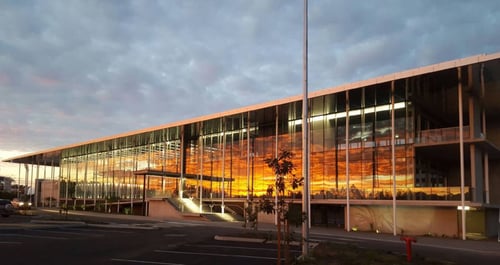As regular readers will know, we like to use our blog to inform you about trends that we spot in the industry. At the moment, we are noticing a return once again to natural zinc finishes.
The benefits of using zinc finishes are vast including its resistance to weather conditions, with the ability to form a natural patina that protects it from rust and corrosion. This provides it with a natural, constantly developing finish.
Other benefits are that zinc cladding is likely to last for several decades and is also completely recyclable. This means that it can be re-used, which makes it effective and environmentally friendly. Our Vitrabond ZN is a natural Zinc composite panel that features a front skin by elZinc of Spain. This finish is known for its elegant shade of grey and with the elZinc there is the option of Slate, Graphite and Rainbow finishes, which opens up new horizons for architectural design and creativity.
The Rainbow finishes features a variety of reds, golds, greens and blues which play with light and the environment. The textured aspect of the pre-weathered zinc shows through the colour, just as the grain in wood is visible through its coat of varnish. Thus, the zinc retains its true character. The pre-weathered Slate and Graphite finishes offer two different surface aspects. These are obtained by immersing natural zinc in a solution which modifies the crystalline structure of the surface of the metal at a thickness of approximately one micron. This chemical treatment creates the surface structure of the metal. The Slate finish is a simple pre-weathered finish, similar to that of the natural patina normally achieved after several years of exposure to the atmosphere whilst Graphite is a charcoal finish on the natural zinc.
Many of us are familiar with the oxidation process of steel, which forms rust. Steel will continue to corrode when rust is present on its surface, eventually rendering it unusable. Zinc, on the other hand, has the ability to resist continued corrosion due to a very unique reaction. Unlike steel, when zinc is exposed to the moisture and carbon dioxide that is present in our atmosphere, a protective layer of zinc carbonate forms on its surface. The resulting zinc-carbonate layer creates a beautiful bluish patina for a very desirable appearance.
In addition to its aesthetic appeal, this protective barrier provides longevity that will allow zinc to protect a building's exterior for years to come. It is not uncommon for a properly designed zinc roof or wall panel system to last over 60 years in most climatic conditions. Another unique characteristic of zinc is that it can "heal" itself overtime. As it continues to patina throughout its life, scratches and imperfections that were once present will virtually disappear.
If you are considering specifying a zinc finish, we recommend taking a look at our new Vitrabond ZN Product Introduction.



